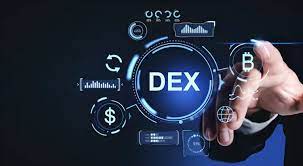In the rapidly evolving world of decentralized finance (DeFi), Uniswap stands out as a foundational protocol that has significantly reshaped how cryptocurrency markets operate. Launched in 2018, Uniswap’s decentralized exchange (DEX) utilizes automated market making (AMM) to provide liquidity to the DeFi ecosystem. By eliminating traditional order books and intermediaries, Uniswap allows users to trade digital assets directly and securely on the Ethereum blockchain.
What is Uniswap?
Uniswap is a decentralized exchange (DEX) built on the Ethereum blockchain. Unlike centralized exchanges like Coinbase or Binance, where orders are matched between buyers and sellers through a central authority, Uniswap relies on smart contracts and liquidity pools to facilitate peer-to-peer trading. This approach makes the platform fully decentralized, allowing users to maintain control over their funds at all times.
The core concept behind Uniswap is Automated Market Making (AMM), a mechanism that automatically determines the price of tokens based on their supply and demand. This differs from traditional exchanges that rely on order books, where buyers and sellers submit bids and asks to determine the price. In an AMM system like Uniswap, liquidity is provided by users who contribute tokens to liquidity pools. Traders can then swap tokens at any time without waiting for an order to be filled.
How Uniswap Works
Uniswap’s success can be attributed to its simplicity and the innovative AMM model it employs. Here’s how the platform works:
- Liquidity Pools: Uniswap is powered by liquidity pools, which are essentially collections of two tokens that users deposit to facilitate trading. These pools are created when liquidity providers (LPs) deposit equal values of two different tokens, such as ETH and USDC. In return, LPs receive liquidity tokens, which represent their share of the pool.
- Automated Pricing: The price of a token in Uniswap is determined by a mathematical formula called constant product formula: x⋅y=kx \cdot y = k. In this formula, x and y represent the quantities of the two tokens in the pool, and k is a constant value. When a user swaps one token for another, the amounts of the tokens in the pool change, and the price adjusts accordingly. This allows for continuous price updates based on supply and demand.
- Swapping Tokens: When a trader wants to swap tokens, they interact with the liquidity pools. For example, if they want to swap ETH for USDC, the smart contract automatically finds the ETH/USDC liquidity pool and adjusts the balance of the tokens in the pool. The price of the swap is determined by the ratio of the tokens in the pool at that moment.
- Incentivizing Liquidity Providers: Liquidity providers are rewarded for their participation in the platform. When they add liquidity to a pool, they earn a small fee on each trade that occurs in that pool, typically around 0.3%. This fee is distributed proportionally to the LPs based on their share of the pool.
Advantages of Uniswap
Uniswap has a number of key advantages that have contributed to its rapid growth and adoption in the DeFi space:
- Decentralization: Uniswap operates without any central authority, meaning no single entity controls the platform. This decentralized nature ensures that users have full ownership and control of their assets at all times, reducing the risk of hacks or mismanagement associated with centralized exchanges.
- Liquidity and Accessibility: One of the main challenges in traditional finance is liquidity. On Uniswap, liquidity is continuously available as long as there are tokens in the pool. Additionally, Uniswap allows anyone to participate in the market by providing liquidity or trading assets. This makes decentralized finance more accessible to a global audience.
- Permissionless and Censorship-Resistant: Uniswap is permissionless, meaning that anyone can use the platform without needing approval from a central authority. The protocol is also censorship-resistant, making it difficult for any government or institution to restrict access or interfere with transactions.
- No Order Book: Traditional exchanges rely on matching buyers and sellers via an order book, but this can result in slow or expensive transactions, especially during periods of high demand. Uniswap’s AMM system removes this bottleneck, allowing for seamless and instant token swaps.
Uniswap’s Evolution: From V1 to V3
Since its launch, Uniswap has undergone several upgrades to improve its functionality and enhance the user experience. These upgrades are often referred to as different “versions” of Uniswap, with each version adding new features and optimizations.
- Uniswap V1: The first version of Uniswap was released in 2018 and introduced the concept of AMM to the world. While it allowed for basic token swaps, its liquidity model was somewhat limited, and it lacked many of the advanced features seen in later versions.
- Uniswap V2: Released in 2020, Uniswap V2 brought several key improvements, such as the ability to trade any ERC-20 token against any other ERC-20 token (without requiring ETH as an intermediary). It also introduced flash swaps, which enabled traders to borrow tokens without collateral for a brief period.
- Uniswap V3: Launched in 2021, V3 was a major upgrade that introduced concentrated liquidity. This allows liquidity providers to allocate their capital more efficiently by concentrating liquidity within specific price ranges, reducing slippage and increasing capital efficiency. V3 also introduced features like multiple fee tiers, allowing liquidity providers to choose how much risk they are willing to take on in exchange for potential rewards.
Uniswap and the Future of DeFi
Uniswap has played a crucial role in the growth of DeFi, allowing users to trade assets and earn rewards without relying on centralized entities. As DeFi continues to expand, Uniswap’s influence is likely to grow, especially as the platform continues to innovate with new features and enhancements.
The rise of Layer 2 solutions (such as Optimism and Arbitrum) is another factor that will likely propel Uniswap to even greater heights. Layer 2 solutions provide faster and cheaper transactions, making them a natural fit for decentralized exchanges like Uniswap. This could further boost liquidity and trading volume, attracting even more users to the platform.
As Uniswap continues to evolve, it stands as one of the most significant pillars of the decentralized financial ecosystem. It demonstrates the power of blockchain technology to disrupt traditional financial systems and create a more open, inclusive, and transparent global economy.
Conclusion
Uniswap has fundamentally changed how we think about cryptocurrency exchanges. Its innovative use of automated market making and decentralized liquidity pools has made it one of the most successful projects in the DeFi space. By eliminating intermediaries and creating an accessible platform for anyone to participate in the market, Uniswap has brought decentralized finance to the mainstream. As the platform continues to evolve, its influence on the broader DeFi ecosystem will only grow, paving the way for a more decentralized and user-centric financial future.



